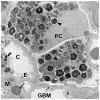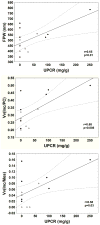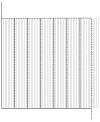Progressive podocyte injury and globotriaosylceramide (GL-3) accumulation in young patients with Fabry disease
- PMID: 21160462
- PMCID: PMC3640823
- DOI: 10.1038/ki.2010.484
Progressive podocyte injury and globotriaosylceramide (GL-3) accumulation in young patients with Fabry disease
Abstract
Progressive renal failure often complicates Fabry disease, the pathogenesis of which is not well understood. To further explore this we applied unbiased stereological quantitative methods to electron microscopic changes of Fabry nephropathy and the relationship between parameters of glomerular structure and renal function in 14 young Fabry patients (median age 12 years). Renal biopsies were obtained shortly before enzyme replacement therapy from these patients and from nine normal living kidney donors as controls. Podocyte globotriaosylceramide (GL-3) inclusion volume density increased progressively with age; however, there were no significant relationships between age and endothelial or mesangial inclusion volume densities. Foot process width, greater in male Fabry patients, also progressively increased with age compared with the controls, and correlated directly with proteinuria. In comparison to the biopsies of the controls, endothelial fenestration was reduced in Fabry patients. Thus, our study found relationships between quantitative parameters of glomerular structure in Fabry nephropathy and age, as well as urinary protein excretion. Hence, podocyte injury may play a pivotal role in the development and progression of Fabry nephropathy.
Figures





References
-
- Meikle PJ, Ranieri E, Ravenscroft EM, et al. Newborn screening for lysosomal storage disorders. Southeast Asian J Trop Med Public Health. 1999;30 (Suppl 2):104–110. - PubMed
-
- Wilcox WR, Oliveira JP, Hopkin RJ. Females with Fabry disease frequently have major organ involvement: lessons from the Fabry Registry. Mol Genet Metab. 2008;93:112–28. - PubMed
Publication types
MeSH terms
Substances
Grants and funding
LinkOut - more resources
Full Text Sources
Other Literature Sources
Medical
Molecular Biology Databases

